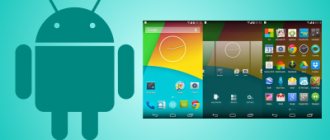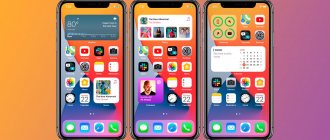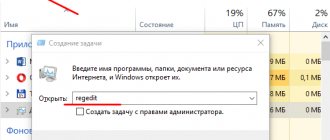Widgets are a handy tool that allows you to get data from an application without having to launch it.
With it, you can find out the time, view information about the weather and traffic jams, change the song or read a message in the messenger - all right on your desktop.
Let's talk about how this option works on different mobile devices.
Let's look at how to add a weather widget or any other application to your phone screen, how to move or delete it, and what to do if for some reason the widget is not installed.
iPhone and iPad
Until recently, iOS users could only add application icons or folders to the desktop. Widgets were installed only in the “Today” section, which was hidden and opened when you swiped left on the first screen.
The situation changed in the summer of 2022, when the new iOS 14 was announced. Now Apple mobile gadgets will officially support on-screen widgets.
Here's how you can add a widget to your iPhone screen:
- Click on an empty space on the desktop until the icons begin to move.
- A plus icon will appear in the upper left corner of your device. Click on it.
- Select the app whose widget you want to host.
- Select the size you want and click on the “Add Widget” button at the bottom of the screen.
- Place the widget in the desired location. You can drag it around your desktop and move it between screens.
- Click on the “Done” button in the upper right corner to complete the setup.
Moving is done in a similar way. Just long-press on an empty area on the screen and drag the desired widget - now you can move it and transfer it to other screens.
To remove it, in the desktop editing menu you need to click on the minus icon in the upper right corner of the widget. Then he will disappear from the screen.
The stable version of iOS 14 will begin to be released in September 2022. But at the moment there is already a public beta version, which provides all the described functionality.
Where can I download widgets for Android devices? Can they be found in the Play Market?
You can download these useful programs on almost any resource that is dedicated to applications and games for Android. There are special sections for this. Below is a list of websites that distribute such programs:
- TrashBox (https://trashbox.ru/apps/android/widget/);
- Top-androids (https://top-androids.ru/widgets/);
- FreeSoft (https://freesoft.ru/android/widgets);
- Programmy-dlya-android (https://programmy-dlya-android.ru/vidzhety/).
Important! It is not recommended to download any games and programs from unofficial resources (developer’s website or the official Play Market digital store). There is a chance of getting a virus or miner into your operating system, which can have serious consequences for the correct operation of the gadget and the confidentiality of personal data stored on it.
You cannot simply install a third-party program from an unofficial source. This will be prevented by a system of protection against unwanted software. To disable it, you must:
- Turn on or unlock your device.
- Go to its main menu and click on the “Settings” application icon.
- Select "Security".
- Among all other settings, select the “Unknown sources” option and activate it.
Note! The setting may be called "Allow installation of programs from unknown sources." It also needs to be switched to the “Active” state.
You can also download widgets from the official Play Market. To do this, you need to enter the name of the program you are interested in in the search. They are usually named after the functions they perform. Next, you simply download and install, and then place the microapplication interface on the desktop in the usual way.
If you have permission to download programs and games only from the Play Store, you can cancel it
Thus, it was explained what Android widgets are, what types they come in and how to install them correctly. Today, on the Internet, there are a lot of really good and useful firmware that can significantly improve the usability of your phone and simply simplify your life through quick access to certain information. They are available for download both from the official store and from other online sources. To install the latter, you will need special permission in the gadget settings.
SMART stacks
The new version of iOS introduced Smart Stacks - this is a special widget that displays information from several applications simultaneously. For example, this way you can combine music, weather and notes so that they do not take up much space separately.
Widgets inside the Smart Stack scroll through automatically, but you can manually switch between them if the need arises. Just scroll down or up.
By default, the system has several Smart Stack options built into it, and you can always create your own. Simply place one widget on top of another and they will merge.
What are widgets used for on Android?
How to remove widgets on Android - detailed instructions
As already mentioned, widgets are most often used to display any information. This could be system data about processor load or the available amount of RAM or internal memory (there are also programs that allow you to quickly clear RAM in one click). In addition, they often resort to widgets with exchange rates, weather, and stock prices of a particular company.
Important! These are very useful programs that make it possible to quickly obtain the necessary information or perform any action - turn on and off the mobile Internet or Wi-Fi, activate Bluetooth and do the same with the GPS module and other equipment.
An application that displays current and current exchange rates of various countries
“Pure” Android
Unlike Apple gadgets, Android devices have always had the ability to add widgets to the screen. Moreover, this option applied to both the desktop and the lock screen of your smartphone.
Here's how to add a widget to your Android screen:
- Unlock your smartphone and pinch a free area on any desktop.
- At the bottom of the screen you will see an icon that depicts four squares. Click on it.
- Select the widget you need and hold it until the desktops appear in front of you.
- Move the widget to the desired screen and place it in any convenient place, and then release your finger.
Also, the ability to place a widget can be built into the application itself. Then you will see the same icon with four squares - just click on it and you will be asked to choose where you want to add the widget.
To move a widget, hold it until it starts to move. Afterwards it can be moved in any direction.
You can also change the size in this menu. If, when pinching, a frame with round markers on the sides appears around the widget, simply move these markets in the desired direction.
To delete a widget, you need to drag it to the top of the screen, where the “Delete” button is located.
Important!
This instruction is only suitable for Android One and devices with “pure” Android, on top of which no shells from the manufacturer have been installed.
Such a system is found on Google Pixel and Nokia gadgets, which are produced by Google itself, as well as on devices from other popular electronics manufacturers. For example, Android One includes Xiaomi Mi A3 and Meizu M10.
What is a widget and why is it needed?
A widget is a small application or one of its elements, which in most cases is located on the desktop and is used to solve a variety of tasks. It is designed to display information and control a mobile device. Using this element, you can obtain information about CPU load, battery status, time, weather, exchange rates, and find out the latest news.
Widget is an important component of the Android operating system interface. Unlike regular applications, you can launch it without opening a new window or taskbar. A significant group of such elements are endowed with the ability to activate the programs of which they are a part.
An important feature of widgets is the variability of borders. Some elements do not exceed the minimum size of 1x1 and resemble a regular shortcut, others can be stretched to the maximum and occupy the entire screen. This is done so that the user can choose in which part of the display to place it. Most mobile devices already have a number of basic interactive elements installed as part of popular programs. In addition to size, they can have different shapes and designs.
As you can see, a widget is a program that “lives” on the screen of a smartphone or tablet, and allows you to receive up-to-date information, as well as comfortably control the device.
Samsung
Since 2022, all Samsung smartphones are provided with the OneUI shell. It has several significant differences from standard Android, but is still similar to it in many ways, so the widget management is similar.
Here's how you can add a widget to your Samsung screen:
- Press your finger on an empty space on the screen or on the “Main Menu” button - the same one that opens the application menu on the device.
- Click on the widget button at the bottom of the screen.
- Select the option you want and drag it to your desktop.
- Choose a suitable place for it and change the size if necessary. This is done in exactly the same way as on “pure” Android.
- Remove your finger from the screen.
Moving or deleting is also standard here. Use a long press and move the widget in the desired direction.
How to move (reorder) widgets in iOS and iPadOS
Once you add a new widget to the list, you can place it however you want.
1. Swipe right on the screen.
2. Scroll down to the bottom of the list of widgets.
3. Click "Edit".
4. Touch and hold the button with three lines to the right of the widget whose location you want to change.
5. Drag the widget up or down.
♥ ON TOPIC: How to check whether you bought a new iPhone (activated or not)?
Huawei and Honor
Since Huawei and Honor smartphones are manufactured by the same company, they have the same shell installed. It's called EMUI, which stands for Emotion UI.
Here's how you can add widgets to the Honor screen:
- Touch the screen with two fingers, and then bring them together. This will open the editing menu in front of you.
- Click on the “Widgets” icon that appears at the bottom of your desktop.
- Select the option you want by swiping the application feed to the right and tap on it.
- Select the appropriate size and click on it.
- Move the widget to your desktop and place it in a convenient place, and then remove your finger.
To move a widget, hold it with one finger and don't let go until it starts moving. Sometimes this may be accompanied by vibration of the phone. Pull it to the desired location or to the edge of the screen if you want to move it to another desktop. Once placed, release your finger.
To delete, you also need to tap on the widget and hold your finger on it for a few seconds. A minus or trash icon will appear at the top of the screen. The exact option depends on the OS version. Move the extra widget there.
The instructions on how to add a widget to the Huawei screen will be similar.
How to restore shortcuts on your phone screen?
To return the shortcut to your Android device:
- open the full list of applications - tap on the icon with squares at the bottom;
- press and hold the application shortcut;
- The desktop will appear, onto which we move the program icon and release it.
Apr 28
2022 Interesting materials:
What is a secondary connection in a router? Wifi direct how to connect iphone? How to connect Wifi direct on lg tv? Wifi screen share lg how to connect? Windows 10 how to connect to another computer? Windows xp how to connect to Wifi? Wo mic how to connect via usb? How to connect Wps on a router? Wps connection what is it? Set as metered connection?
Xiaomi
The shell of Xiaomi gadgets is called MIUI. In many ways, it resembles EMUI and standard Android, so managing widgets here will be similar.
Here's how you can add a widget to your Xiaomi screen:
- Open any desktop. Hold your finger in an empty space on the screen or pinch two fingers together - you can use both options here.
- Click on the “Widgets” button, which is located centrally at the bottom of the screen.
- Scroll down the page to select the option that suits you. Here, all widget sizes are displayed at once: just click on the one you need when you make your choice.
- Drag the widget onto your desktop, place it in the desired location, and release your finger.
To move or delete you need to use long press.
After the widget starts moving, drag it to the desired location or to the top of the screen - to the “Delete” button with a cross.
How to add new widgets on iPhone or iPad
In addition to Apple's built-in options, you can add widgets from third-party developers. There are several ways to do this.
1. Swipe right on the Home or Lock screen, or open Action Center to view your widgets.
2. Scroll down to the bottom of the list of widgets.
3. Click "Edit".
4. Scroll down to find the widget you want to add.
5. Click the green “+” button next to the desired widget.
6. Click "Done".
The method described above is used in older versions of iOS, but starting with iOS 10, an additional option is available, which some developers are already actively using.
1. Find the app whose widget you want to add to your home screen.
2. Touch and hold an application icon to activate the pop-up menu.
3. Click “Add Widget” if this option is available.
♥ ON TOPIC: How to set a ringtone on any iPhone without a computer?
Why is the widget not being added?
Sometimes this happens - you try to install the desired option, but the message appears: “It is impossible to add a widget to the home screen.” The text may be different, but the general meaning remains the same.
Most often this is due to blocking screen changes.
Here's how to disable it on Android:
- Long press or pinch your fingers together on the screen to open the editing menu.
- Click on the “Settings” icon. Sometimes there may be a signature underneath, but if there isn't one, it's most likely a picture of a gear.
- Find the item “Protect from tampering”, “Lock home screen” and any option that corresponds to it.
- Uncheck it or pull the switch to deactivate the lock.
Now you can add any widget to your home screen.
Why does the widget not display information?
Sometimes after installation the widget may start to crash. It seems to be present on the screen, but does not show the data or shows it incorrectly. For example, it might show an old date or a song you're not currently listening to.
Most often this happens for the following reasons:
- Your cache is overloaded. Just run your phone settings and clean it and the problem will go away on its own.
- You need to install the update. This may apply to the device itself or to the application whose widget refuses to work. Also sometimes it is a matter of updating standard Google programs.
- The application has crashed. Try opening and closing it - sometimes this helps.
The easiest way to solve the problem is to first remove and then re-add the widget to your phone screen. If this doesn't help, try reinstalling the application.
What are Smart Stacks?
Smart stacks are neat widgets that will automatically switch between different widgets throughout the day, showing information that is relevant to the user. At the same time, in Smart Stacks you can manually scroll through the various available options at any time.
iOS 14 brings Apple's new weather app, and widgets offer real-time precipitation and severe weather tracking for a great visual experience.
♥ ON TOPIC: How to teach your iPhone to pronounce the name of the person calling you.
How to add a widget to your lock screen
The availability of this function depends not only on the operating system and its version, but also on the manufacturer - the shell used. So, on Android OS this functionality was available in versions 4.0-4.4, as well as later ones from different manufacturers. iOS phones do not have this option.
To add a widget to your lock screen, do this:
- Open main settings and select “Lock screen”.
- Open the “Widgets” menu item.
- Choose what information appears on the lock screen.
- Customize the display order.
The number of widgets you can use in this mode is limited. This is due to the small amount of free space on the lock screen. Widgets will be available as cards when you tap on the lock screen clock.
Main types of widgets
Above you learned that widgets are different. Let's take a closer look at their types to understand the difference, areas of use and advantages of these small tools.
Desktop widgets (desktop-widgets)
The most common among ordinary users are widgets for the computer desktop or the home screen of a mobile device. Such applications or add-ons can be called desktop-widgets, which makes their main purpose clear.
Let's first look at widgets for a computer running Windows (the new macOS and many Linux distributions also support them). The Microsoft product used to support third-party gadgets (synonymous with widgets); Windows 7 even had a built-in application with different windows that displayed both useful information and mini-games.
Later, the OS developers abandoned them (it turns out that the widgets were unsafe) and “cut out” all these desktop windows from the operating system. Now Windows users have only one option - install additional applications to work with them. There are programs that specialize exclusively in widgets and allow you to add any auxiliary screens, as well as customize them as you wish, not only in terms of appearance, but also functionality.
Rainmeter is considered one of the best solutions. If you wish, you can go to the official website of the developers and familiarize yourself with the functionality of this solution. The above program is mentioned as an example only.
If everything is clear with computers, then widgets on the phone, although they work similarly, have their own characteristics. Mobile operating systems have standard gadgets that are implemented in completely different ways. In iOS, even third-party solutions look standardized and allow you to create a nice composition of several different widgets placed on the home screen.
Android is more complicated because there are no restrictions or guidelines on the appearance and functionality of widgets. With the right approach, you can create a harmonious display of them, but this will take more time.
It’s also worth talking a little about functionality. On iOS, many widgets do more than just allow you to view general information about the weather or battery charge, which can be done in a few seconds without this tool. Many of them allow you to perform some simple operations and interact in every possible way with the programs for which they support. In Android, many such gadgets are completely useless or perform functions that can be implemented without them with just a couple of clicks inside the target application.
Adding widgets to mobile operating systems occurs using the shell ribbon or the operating system itself, which will be discussed in more detail in one of the following sections of the article.
Widgets for websites (web-widgets)
The second type of elements under consideration is web-widgets. The user may see similar applications when browsing modern websites. Their topic directly depends on the direction of the site, because no one needs to add a call back widget to an online movie theater.
Such solutions not only make the site more beautiful and convenient in terms of functionality, but also allow you to retain the client, re-attract his attention, provide quick consultation, or perform many other different actions. Next, I'll look at two popular types of web widgets to give you a basic understanding of how they work.
Callback widget
Some sites specialize in sales, so they often communicate with clients by phone to discuss order details. A callback widget is an active window that pops up at a certain moment, for example, when the user wants to leave the site. Usually in this window there is a message that they will call you back within a minute and give you a discount, you just need to leave your phone number.
I will also mention such an addition for sites as a form for sending messages. This could be feedback or dialogue (chat) with a company representative in real time, for example, when you need to get quick support.
It is believed that these elements have a beneficial effect on user interest and increase conversion and sales. Such widgets can be ordered from specialized companies or made yourself if you have the appropriate knowledge.
Countdown timer
As a second popular option, I’ll consider a countdown timer. By the name of this widget, its purpose is already clear - it is not active and only displays on the screen the time until the end or start of an event. This could be a widget for the deadline before the end of a promotion or the start of a sale.
Although a countdown timer is considered a widget, it is sometimes embedded on a website as a GIF or other type of animation, which depends on the implementation of the task by the web developer. There are even special online services that allow you to create a unique countdown widget in a few clicks, choose a design for it, and receive an HTML code to insert into your website.











